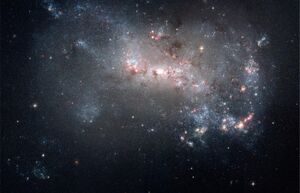Astronomy:NGC 4449
| NGC 4449 | |
|---|---|
 A Hubble Space Telescope (HST) image of NGC 4449. | |
| Observation data (J2000 epoch) | |
| Constellation | Canes Venatici[1] |
| Right ascension | 12h 28m 11.9s[2] |
| Declination | +44° 05′ 40″[2] |
| Redshift | 207 ± 4 km/s[2] |
| Distance | 13.08 ± 0.98 Mly (4.01 ± 0.30 Mpc)[3] |
| Apparent magnitude (V) | 10.0[2] |
| Characteristics | |
| Type | IBm[2] |
| Apparent size (V) | 6′.2 × 4′.4[2] |
| Other designations | |
| UGC 7592,[2] PGC 40973,[2] Caldwell 21 | |
NGC 4449, also known as Caldwell 21, is an irregular Magellanic type galaxy in the constellation Canes Venatici, being located about 13 million light-years away.[3] It is part of the M94 Group or Canes Venatici I Group that is relatively close to the Local Group hosting our Milky Way galaxy.[4][5]
Characteristics
This galaxy is similar in nature to the Milky Way's satellite galaxy, the Large Magellanic Cloud (LMC),[6] though is not as bright nor as large. NGC 4449 has a general bar shape, also characteristic of the LMC, with scattered young blue star clusters.
Unlike the Large Magellanic Cloud, however, NGC 4449 is considered a starburst galaxy due to its high rate of star formation (twice the one of the LMC)[7] and includes several massive and young star clusters,[8][9] one of them in the galaxy's center.[10]
Photos of the galaxy show the pinkish glow of atomic hydrogen gas, the telltale tracer of massive star forming regions.
NGC 4449 is surrounded by a large envelope of neutral hydrogen that extends over an area of 75 arc minutes (14 times larger than the optical diameter of the galaxy). The envelope shows distortions and irregularities likely caused by interactions with nearby galaxies.[11]
Interactions with nearby galaxies are thought to have influenced star formation in NGC 4449 and, in fact, in 2012 two small galaxies have been discovered interacting with this galaxy: a very low surface brightness disrupted dwarf spheroidal with the same stellar mass as NGC 4449's halo but with a ratio of dark matter to stellar matter between 5 and 10 times that of NGC 4449[12] and a highly flattened globular cluster with two tails of young stars that may be the nucleus of a gas-rich galaxy.[13] Both satellites have apparently been disrupted by NGC 4449 and are now being absorbed by it.[12][13]
At least one ultraluminous X-ray source (ULX) is known in NGC 4449, called NGC 4449 X7. There are three candidates that have been identified as optical counterparts to NGC 4449 X7 (i.e. they may be associated with the ULX). They are all early (B-type to F-type) supergiants that are estimated to be about 40 to 50 million years old and about 8 times the mass of the Sun.[14]
References
- ↑ R. W. Sinnott, ed (1988). The Complete New General Catalogue and Index Catalogue of Nebulae and Star Clusters by J. L. E. Dreyer. Sky Publishing Corporation and Cambridge University Press. ISBN 978-0-933346-51-2.
- ↑ 2.0 2.1 2.2 2.3 2.4 2.5 2.6 2.7 "NASA/IPAC Extragalactic Database". Results for NGC 4449. http://nedwww.ipac.caltech.edu/.
- ↑ 3.0 3.1 Sabbi, E. et al. (2018). "The Resolved Stellar Populations in the LEGUS Galaxies". The Astrophysical Journal Supplement Series 235 (1): 23. doi:10.3847/1538-4365/aaa8e5. Bibcode: 2018ApJS..235...23S.
- ↑ Karachentsev, I. D. (2005). "The Local Group and Other Neighboring Galaxy Groups" (in en). The Astronomical Journal 129 (1): 178–188. doi:10.1086/426368. ISSN 1538-3881. Bibcode: 2005AJ....129..178K. http://stacks.iop.org/1538-3881/129/i=1/a=178.
- ↑ "Nearby Groups of Galaxies". http://ned.ipac.caltech.edu/level5/Dev2/frames.html.
- ↑ Karachentsev, Igor D.; Karachentseva, Valentina E.; Huchtmeier, Walter K.; Makarov, Dmitry I. (2003). "A Catalog of Neighboring Galaxies". The Astronomical Journal 127 (4): 2031–2068. doi:10.1086/382905. Bibcode: 2004AJ....127.2031K.
- ↑ Annibali, F.; Aloisi, A.; Mack, J.; Tosi, M. et al. (2008). "Starbursts in the Local Universe: New Hubble Space Telescope Advanced Camera for Surveys Observations of the Irregular Galaxy NGC 4449". The Astronomical Journal 135 (5): 1900–1916. doi:10.1088/0004-6256/135/5/1900. Bibcode: 2008AJ....135.1900A.
- ↑ Reines, Amy E.; Johnson, Kelsey E.; Goss, W. M. (2008). "Emerging Massive Star Clusters Revealed: High-Resolution Imaging of NGC 4449 from the Radio to the Ultraviolet". The Astronomical Journal 135 (6): 2222–2239. doi:10.1088/0004-6256/135/6/2222. Bibcode: 2008AJ....135.2222R.
- ↑ "Dynamical Mass Estimates for Five Young Massive Stellar Clusters". The Astronomical Journal 128 (5): 2295–2305. 2004. doi:10.1086/424538. Bibcode: 2004AJ....128.2295L.
- ↑ Böker, Torsten; van der Marel, Roeland P.; Mazzuca, Lisa; Rix, Hans-Walter et al. (2001). "A Young Stellar Cluster in the Nucleus of NGC 4449". The Astronomical Journal 121 (3): 1473–1481. doi:10.1086/319415. Bibcode: 2001AJ....121.1473B.
- ↑ Bajaja, E.; Huchtmeier, W. K.; Klein, U. (1994). "The extended HI halo in NGC 4449". Astronomy and Astrophysics 285: 385–388. Bibcode: 1994A&A...285..385B.
- ↑ 12.0 12.1 Martínez-Delgado, David; Romanowsky, Aaron J.; Gabany, R. Jay; Annibali, Francesca et al. (2012). "Dwarfs Gobbling Dwarfs: A Stellar Tidal Stream around NGC 4449 and Hierarchical Galaxy Formation on Small Scales". The Astrophysical Journal Letters 748 (2): L24. doi:10.1088/2041-8205/748/2/L24. Bibcode: 2012ApJ...748L..24M.
- ↑ 13.0 13.1 Annibali, F.; Tosi, M.; Aloisi, A.; van der Marel, R. P. et al. (2012). "Cluster 77 in NGC 4449: The Nucleus of a Satellite Galaxy Being Transformed into a Globular Cluster?". The Astrophysical Journal Letters 745 (1): L1. doi:10.1088/2041-8205/745/1/L1. Bibcode: 2012ApJ...745L...1A.
- ↑ Ela, M Ozdogan; Akyuz, A.; Aksaker, N.; Avdan, S.; Oralhan, I Akkaya; Vinokurov, A.; Allak, S.; Solovyeva, Y. et al. (2021). "Optical counterparts of ULXs in two dwarf galaxies: NGC 4861 and NGC 4449". Monthly Notices of the Royal Astronomical Society 505: 771–782. doi:10.1093/mnras/stab1321.
External links
- Astronomy Picture of the Day – May 3, 2007, 10 July 2007, and 25 February 2011
- NGC 4449 on WikiSky: DSS2, SDSS, GALEX, IRAS, Hydrogen α, X-Ray, Astrophoto, Sky Map, Articles and images
 |

